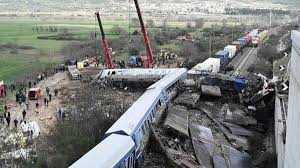
Two trains have smashed into each other at high speed in Greece killing at least 36 people and injuring many more. The horrific incident occurred as a service carrying around 350 passengers, emerged from a tunnel in the municipality of Tempi, around 15 miles (24km) from the city of Larissa.
It was on its way to Thessaloniki having earlier left the capital Athens, and hit a freight train on the same track late on Tuesday (28 February). It is understood that the first two carriages of the passenger train were almost completely obliterated after bursting into flames. Rescuers have been working through the night and continue to try to free those trapped, with survivors describing a terrifying scene of utter chaos and carnage.
Cranes and special lifting equipment have been brought to the crash site to help clear the wreckage and debris, and lift the rail cars. It is unclear how the accident could have happened in what is already being ranked as the worst train crash Greece has ever seen.
The President of the country, Katerina Sakellaropoulou, has cut short an official visit to Moldova to rush to the tragedy. The Greek prime minister has announced that Greece will enter a three day period of mourning.
Shortly after midday today (1 March) the station master of the city of Larissa was arrested and charged with manslaughter by negligence.
Two trains travelling at speed on the same line
The passenger train had left Athens on Tuesday (28 February) at 19:30 local time for the 310 mile (500km) journey to Thessalonika which usually takes just under six hours to complete. Shortly before midnight and close to the city of Larissa in northern Greece, the train emerged from a long tunnel to continue it route at high speed, believed to be in the region of 100mph (160kmh), on the railway line that runs alongside farmland, and the Pinelos River to its west, with the foothills of Mount Ossa to its east.
It seems that a freight train had left Thessalonika and was also moving at speed towards its destination in Larissa. With neither driver aware of the others presence on the line, they smashed into each other, to devastating effect. It appears that the first four carriages of the passenger train were derailed, with the leading two “almost completely destroyed” after catching fire. Marina Rigou, a Greek journalist said she had spoken to the Mayor of the city close to the incident who confirmed: “The collision was so severe that the two first carriages just disappeared.”
Footage of the aftermath of the crash showed thick plumes of smoke rising from derailed carriages. Investigators from Athens and Thessaloniki have been dispatched to assist local authorities to try and establish cause.
Rescuers continue to search
Something like 150 firefighters and 40 ambulances were dispatched to the site, with paramedics heavily involved. Rescuers worked tirelessly to reach the trapped and injured, as well as sadly removing the dead from the carriages. Volunteers were also on hand to help wherever they could, but the tragic scene was one of utter devastation.
One rescuer said: “We are living through a tragedy; I have never seen anything like this in my entire life.” Another rescue worker who was close to exhaustion having been battling through the wreckage for hours remarked: “This is tragic; five hours later, and we are still finding bodies.”
Red cross appeal for blood donations
Red Cross volunteers have been among those at the scene helping to transport the dead and injured. They have also been providing psychological support for victims’ families and a short time ago they announced that it is organising emergency blood donation in the central square of Larissa, in collaboration with two local hospitals in order to help those who were injured in the crash.
Panic and fire
Survivors have been reliving the terrifying moments immediately after impact. Stergios Minenis told of hearing a loud bang then described the next ten to fifteen seconds as “nightmarish”. He said: “We were turning over in the carriage until we fell on our sides; then there was panic. The fire was immediate, as we were turning over we were being burned.”
He spoke of chaos, cables hanging down, broken windows, people screaming, or being trapped. He explained that he jumped from around two metres high to leave the train landing on broken iron debris, “but what could we do?” he asked, whilst still understandably in a state of shock.
Impact like an earthquake
Angelos Tsiamouras likened the impact to that of an earthquake, whilst another shaken passenger who miraculously escaped the crash, painted the petrifying picture of very strong braking, windows suddenly exploding, sparks and flames on the sides, people screaming, and blood everywhere.
Relief at getting out
Greek reporter Alexia Kalaitzi, chatted to survivors in Thessaloniki and was told by one how he felt the whole train car going sideways before it completely collapsed, but luckily had been able to escape through a hole. Others described using their luggage in order to smash the windows to get out, before realising how fortunate they had been when seeing to their horror, the first two carriages on fire.
Desperate parents waiting at station
Many of those on board were students returning from holidays in the capital for Greek Orthodox lent and in lots of case their parents were waiting for them at Thessaloniki train station, who were in desperate panic trying to discover if their children had survived.
Rail union boss makes tunnel remark
Yannis Ditsas, president of the Panhellenic Federation of Railway Workers union said it was a mystery how the accident could have happened and it is too early to tell whether the mistake was made on the ground, with signals, or on the train itself. He did add that if there is one consolation, if that is the right term, it was that the crash did not happen inside tunnel it had just left, as that would have led to many more deaths and even worse carnage.
President to visit the scene
The President of Greece, Katerina Sakellaropoulou, cut short an official visit to Moldova to head straight to the crash site. She said in a brief statement: “Unfortunately, I have to interrupt my visit in order to be close to my people, to support those who need it.”
Rail system in need of modernisation
Greece’s ageing railway system is in need of modernising, with many trains travelling on single tracks and signalling and automatic control systems still to be installed in many areas. Just over fifty years ago, back in 1972, two trains collided very close by, just outside Larissa, and on that occasion 19 people lost their lives.
Thirty-six declared dead but number could still rise
As at 10am local time today (1 March), the number of dead from this tragedy was put at 36, with a further 72 injured, of whom 6 were reported to have been transferred to intensive care. A spokesperson for the fire service said sadly the number of dead is likely to rise and explained that identifying people was also proving “very difficult” because temperatures exceeded 1,300C in the immediate areas where the fire broke out.
Government to pay for funerals
Greece’s government has announced that the country will pay for the funerals of all those who have lost their lives in the tragic train crash. Local media reported that the decision to pay for the services at public expense was taken by the minister of the interior, Makis Voridis and minister of finance Christos Staikouras.
Station master arrested and charged
The Greek authorities have reacted swiftly and just after midday on Wednesday 1 March the station master of the city of Larissa was arrested and duly charged with manslaughter and grievous bodily harm by negligence. Police say that the 59-year-old, who is in charge of signalling, denies any wrongdoing and has blamed the accident on a possible technical failure.
PM declares three days national mourning
Three days of national mourning declared by the prime minister of Greece who said all public celebrations are cancelled and the flags on public buildings will fly at half mast until Friday 3 March.













0 Comments